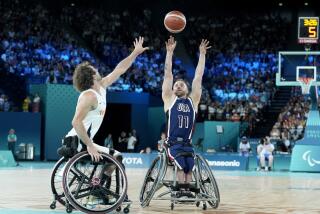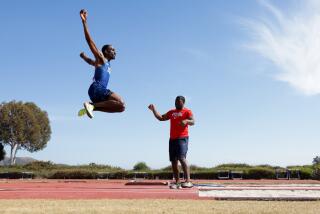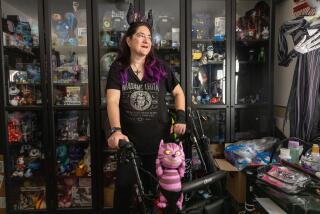Handicapped Experience the Joys and Thrills of Water-Skiing : Recreation: Special sleek platform gives them the chance to zip around Mission Bay.
- Share via
When you ride one of these things, getting up is not the hard part, though no one who has ever done it would say that that stage is particularly easy.
Once the boat has launched you up on the waves, it is a bizarre and disorienting situation as you try to balance yourself while crouching on a sleek moving platform that provides about as much, or maybe less, stability as a pair of ill-fitting roller skates.
Meanwhile, salt spray peppers your face at 20 m.p.h.
“It gets pretty squirrelly pretty fast,” Valdemar Arild said as he prepared a paraplegic for a ride on this contraption off the south end of Mission Bay’s Fiesta Island.
Sound hard? You bet, but some hardy souls try it anyway. And some have more success than their instructors.
One is Joe Garrett, who lost the use of the lower half of his body just over two years ago.
The first pull was rough for Garrett, who was unprepared for the jerking acceleration of the speedboat. The second time wasn’t much of a success, either.
But the third pull lasted about 30 yards as Garrett, 33, started sliding back and forth over the surf, trying to balance himself with his free hand, but eventually ditching.
Garrett and a few other disabled people were water-skiing. Actually, they were participating in a more difficult variation of it, and having a hell of time.
Peter Ballentyne, an accomplished water-skier and instructor secure in his own ability, had no problem admitting it took him a dozen tries before he went any distance on the Kan-Ski, a 5-foot-long, foot-wide ski centered by a slightly raised seat on which the skier squats.
Standing next to him, Dave Lichtenstein grudgingly acknowledged that, yes, all right, he too took a lot of time to get up on the ski, even though he’s a Solana Beach lifeguard and Mission Bay sailing instructor.
The two of them, with volunteer help from other water sports instructors, run a program that gives the handicapped--paraplegics, quadriplegics, amputees and others--a chance to water-ski using modified equipment that, for other people, is actually harder to ride than regular water-skis.
Many of the participants are still adjusting to lives with disabilities. For many, the water-skiing marks the first time they have been involved in a sport since their injury.
The decade-old program, once funded by a federal grant, is now threatened. This summer’s schedule, financed by the Torrey Pines Kiwanis Club, was shortened to the five Wednesdays in August. In previous years, the program continued throughout summer.
Ken Force lost the use of his legs in 1975 while in the U.S. Army in West Germany. He was shot by another soldier, who was fooling around with a .45-caliber automatic pistol in their barracks.
Since then, Force has taken up scuba diving, which has allowed him to explore the waters off California and Hawaii and in the Caribbean.
Water-skiing, though, was a whole new ball game.
“You really have no idea about what direction you’re going when you’re up,” he said. And did he stay up on his first trip? “Yeah, but I’m not going to say anything more because I’ll jinx myself.”
For his first ride, Force used a wider and more stable ski that allowed him to make his maiden voyage without falling into the bay.
“It’s refreshing. I mean, you don’t get sprayed in the face every day,” he said.
The program opens up a realm of possibilities to a group of people who must deal with the stereotypes attached to the handicapped.
“It proves to them that things they thought might have been taken away really haven’t been,” Ballentyne said. “It gets them out of a hospital and into a recreational setting.”
Ballentyne, who runs the water-skiing instruction at the Mission Bay Aquatic Center, adopted the job after first volunteering and then realizing how much it meant to him. “It’s a two-way street,” he said.
Lichtenstein said the program helps disabled people see there are still a lot of things they can do.
“It helps them with everything, especially their self-esteem,” he said. “It lets them know that they can actually go out for a weekend with their friends” just as before their injury.
And how about the ride?
“I really enjoyed it,” Garrett said. “I used to water-ski before, and it feels just like it when you’re getting up.”
For Ralph Shadowens, 31, it was the first time back in the water after an injury eight months ago that left him wheelchair-bound. He managed a whole ride without a dunking.
“It feels real good,” he said. “I’m probably not as active as I should be. I want to do more of this, definitely. It feels good just to be back out in the saltwater.”
Although Ballentyne and friends run the program, finding the participants is left up to Steve Kaliszewski, who runs the wheelchair sports program at Sharp Memorial Hospital.
The hospital and Mission Bay Aquatic Center, with help from the Torrey Pines Kiwanis, will host a “Day on the Bay” on Sept. 24 off Crown Point, where handicapped will be able to ski, sail, go kayaking and jet-ski.
More information on the event, the water-skiing program and other sports for the disabled is available from Kaliszewski at 541-3048.


